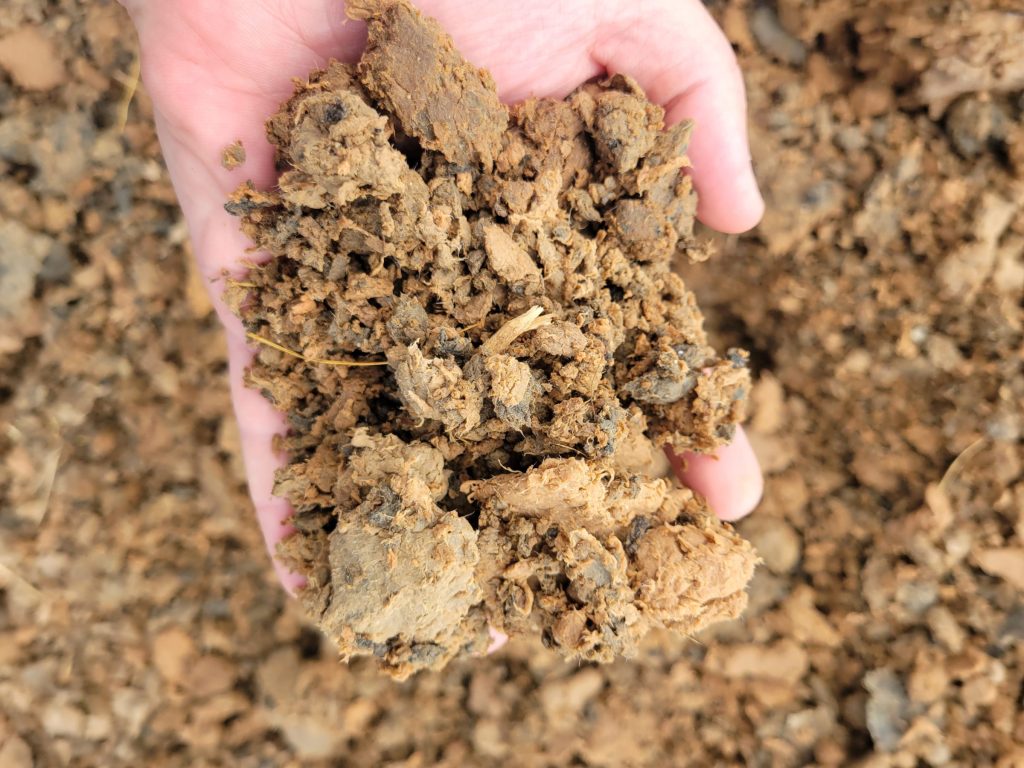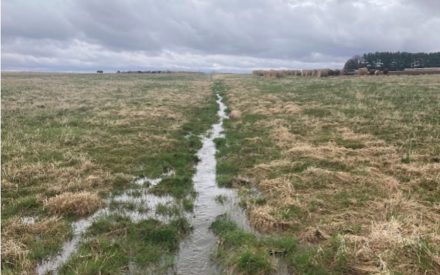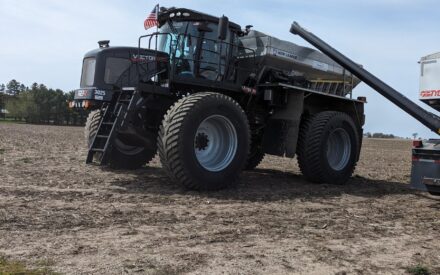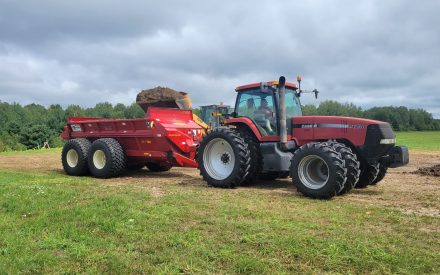Incorporating Off Farm Wastes in Nutrient Management Planning
Limiting Nutrient for Material Application
Application restrictions near wells and/or buildings
Application restrictions based on depth to ground water and bedrock
Application restrictions near surface water
Winter (frozen or snow covered ground) spreading restrictions
A Summary of Manure, Sewage Sludge, Septage, Industrial Wastes, and Wood Ash Application Restrictions on Wisconsin Farms
Nutrient Management Plans (NMPs), regulated under chapter ATCP 50 of the Wisconsin Administrative Code, guide nutrient applications and conservation practices on farms that mechanically apply nutrients to cropland and pasture. While the Nutrient Management Performance Standards in WI chapter NR 151 and the USDA NRCS 590 Nutrient Management Practice Standard provide direction for manure and commercial fertilizers. However, the standards do not provide guidance for application of:

- Industrial wastes (industrial liquid waste, industrial by-product solids, and industrial sludge regulated under WI chapter NR 214)
- Municipal sewage sludge (regulated under WI chapter NR 204)
- Septage (regulated under WI chapter NR 113)
Note: Manure regulations may apply if these materials are co-mingled with manure.
However, all nutrient sources, including industrial waste, sludge, and septage, must still be accounted for in the Nutrient Management Plan. Depending on the nutrient content and application rate of these materials, they may limit future applications of manure or commercial fertilizer to remain within agronomic rates.
This guidance document is intended to assist crop consultants, conservation staff, and farmers in properly accounting for these materials when developing an NMP. It provides clarification on nutrient application rates, surface and groundwater setbacks, and winter spreading restrictions related to the land application of industrial byproducts, municipal sludge, and septage. Any application of these materials must be approved and permitted by the Wisconsin Department of Natural Resources.
The following terms will be used as a description of the nutrient management performance standards and state statutes referred to in the introduction in the below restriction descriptions.
Manure: USDA NRCS 590 and NR 151
Sewage: WI ch. NR 204 including municipal sewage sludges
Septage: WI ch. NR 113 this includes septage from septic tanks, holding tanks, grease interceptors, portable restrooms
Industrial: WI ch. NR 214 including the following wastes as defined below:
- Liquid waste: process wastewater and waste liquid products. This includes silage leachate, whey, whey permeates, whey filtrate, contact cooling water, cooling or boiler water containing water treatment additives, and wash water generated in industrial, commercial and agricultural operations which result in a point source discharge to a land treatment system.
- By-product solids: waste materials from the animal product or food processing industry including, but not limited to remains of butchered animals, paunch manure and vegetable waste materials such as leaves, cuttings, peelings and actively fermenting sweet corn silage.
- Industrial sludges: accumulated solids generated during the biological, physical or chemical treatment, coagulation or sedimentation of water or wastewater.
Limiting Nutrient for Material Application
The following information outlines which nutrient primarily limits the application of the material being applied according to the restrictions in the statute.
Manure
Limiting nutrient: Nitrogen and phosphorus based
If the average Phosphorus Index (P Index) is above 6 for up to an 8-year rotation, additional phosphorus applications may only be made according to University of Wisconsin-Madison Division of Extension Nutrient Application guidelines for field, vegetable, and fruit crops (A2809) recommendations.
Soil test P Strategy
- Less than 50 ppm – application rates allowed up to N needs of the following crop or the N removal of the following legume crop
- 50-100 ppm – phosphorus application shall not exceed the total crop P removal for crops to be grown over the rotation up to eight years.
- Greater than 100 ppm – total P applications from all sources shall not exceed guidelines from A2809. If manure application is necessary, then applied phosphorus rate must be 25% less than the crop rotation removal of no more than eight years.
See additional information on applications on frozen or snow covered ground below in Winter spreading restrictions section.
Sewage
Limiting nutrient: Nitrogen based (Using standard mineralization rate unless otherwise specified).
Note: While sewage applications are nitrogen based, WPDES permits require phosphorus and potassium sampling. Analytical results should be provided for farmers and nutrient management planners to be included in the nutrient management plan.
- The rate of nitrogen applied from sludge and other sources may not exceed the University of Wisconsin-Madison Division of Extension Nutrient Application guidelines for field, vegetable, and fruit crops (A2809) recommendations
- May apply up to 140 pounds/acre/crop year of available N to soybeans
- May apply up to 200 pounds/acre/crop year of available N to other leguminous crops
- If not specified by the lab analysis data, use the mineralization rates of: 1st year 25%, 2nd year 12%, and 3rd year 6% (reference: s. NR 204.07(8), Wis. Adm. Code).
- The pH of the soil should be 5.5 or higher for non-radium containing sludges. The pH of the soil shall be 6.0 or higher for sewage sludges containing radium.
- Application is restricted for certain human food crops (see s. NR 204.07 “Table C” Wis. Adm. Code for more details).
- See additional information on applications on frozen or snow-covered ground below in winter spreading restrictions section.
Septage
Limiting nutrient: Nitrogen based
- There is no requirement to test septage nutrient levels.
- The rate is determined by the University of Wisconsin-Madison Division of Extension Nutrient Application guidelines for field, vegetable, and fruit crops (A2809) recommendations using the following equation and if the field is determined as high use (above 39,000 gallons per acre per crop year) or low use (39,000 or less gallons per acre per crop year)
Annual Agronomic Rate = N recommendation for crop / 0.0026
Estimates 2.5 pounds of N per 1,000 gallons
- Those fields determined to be high use fields may spread up to the N need of the crop using the above equation.
- Those fields determined to be low use fields have a max application rate of 39,000 gallons per acre per crop year (approximately 100 pounds of nitrogen per acre per crop year) and are require to use the above equation.
- May apply up to 140 pounds/acre/crop year of available N to soybeans. This situation would only occur on a high use field.
- May apply up to 200 pounds/acre/crop year of available N to other leguminous crops
- May not be applied >10 months prior to planting a crop. This situation would only occur on a high use field.
- Maintain at least 2 foot grass strip at down slope property line
- Application is restricted to for certain human food crops (see s. NR 113.07(3)(d), Wis. Adm. Code for more details).
- See additional information on applications on frozen or snow covered ground below in Winter spreading restrictions section.
Industrial
Limiting nutrient: Nitrogen based on TKN unless otherwise specified.
Note: While industrial waste landspreading is nitrogen based, WPDES permits require phosphorus and potassium sampling. Analytical results should be provided for farmers and nutrient management planners to be included in the nutrient management plan.
- Application rate based on representative sample of waste (TKN) not to exceed the nitrogen needs of the crop. Note: Industrial permittees have the option to perform their waste-specific nitrogen mineralization rate studies. Once approved with the DNR, this study can be shared with nutrient management planners.
- Application rates are also limited by chloride content (170 lbs/acre/year or 340 pounds/acre/2 years)
- Whey application: First year 27,150 gallons, second year 20,360, and following years 13,600 gallons
- Other liquid applications not to exceed 13,500 gallons per acre per day not to exceed weekly allowed amount (see Chart 1 below)
- Incorporate by-product solids and industrial sludges as specified in WPDES permit or approved DNR management plan.
- Limited to a slope of <12% when soil temperatures are above freezing (see additional restrictions for frozen or snow-covered ground in Winter spreading restrictions section)
- Spread solid stockpiles within 72 hours within delivery to field.
Chart 1. Industrial Waste Maximum Weekly Volume of Liquid Waste to be Applied (gal/ac/week or acre inches/week)
| 18-36″ to groundwater or bedrock | Greater than 36″ to groundwater or bedrock | |
|---|---|---|
| Sand | 6750 (¼ inch) | 13500 (½ inch) |
| Sandy Loam | 13500 (½ inch) | 27000 (1 inch) |
| Loam | 13500 (½ inch) | 27000 (1 inch) |
| Silt Loam | 13500 (½ inch) | 27000 (1 inch) |
| Clay Loam | 13500 (½ inch) | 20000 (¾ inch) |
| Clay | 6750 (¼ inch) | 13500 (½ inch) |
Note: Lowest application rate is applied to the entire field. For example, if a field contains both sand and silt loam soil map units, application rate would be restricted to 13,500 gallons/acre/week.
Application restrictions near wells and/or buildings
The following chart lists application restrictions near wells and buildings. If an application occurs near a building that has a well, the application must follow the more restrictive application requirements based on either the existence of a well, or the presence of the buildings.
Applications near wells
| Nutrient Source | Community Wells1 | Non-community Wells2 | Private Wells3 | Irrigation/non-potable wells |
|---|---|---|---|---|
| Manure4 | 1000 feet | 100 feet | 50 feet | 8 feet |
| Sewage | 1000 feet5 | 250 feet | 250 feet | 250 feet |
| Septage | 1000 feet6 | 250 feet | 250 feet | 250 feet7 |
| Industrial | 1000 feet | 250 feet | 250 feet | n/a |
- Wells for a town, village, city
- Wells that include public places such as schools, restaurants, etc. unless otherwise noted in the table
- Wells for private residences
- Unless manure is treated or deposited by grazing animals
- Includes schools
- Includes schools and healthcare facilities
- Distances to non-potable wells used for irrigation or monitoring may be reduced to 50 ft. if the septage is incorporated or injected and the Department of Natural Resources does not determine that a greater distance to the wells is required to protect the groundwater.
Application restrictions near residential or other building sites
Definitions used regarding tillage and biosolid as defined in NR204 (sewage sludge), NR113 (septage), and NR214 (industrial waste):
- Incorporation: mixing with topsoil to a minimum depth of 4 inches through discing, moldboard plowing, chisel plowing, rototilling, or other tillage methods
- Injected: subsurface placement of liquid sludge to a depth of 4 to 12 inches.
Sewage
| Not incorporated | Incorporated | Injected | |
|---|---|---|---|
| Residence, business, or recreation area | 500 feet | 200 feet | 200 feet |
| Residence or business with permission | 250 feet | 100 feet | 100 feet |
| Rural schools and health care facilities | 1000 feet | 1000 feet | 500 feet |
| Distance to property line1 | 50 feet | 25 feet | 25 feet |
- Distance may be reduced with written permission from both owners and occupants
Septage
| Not incorporated | Incorporated | Injected | |
|---|---|---|---|
| Residence, business, or recreation area | 500 feet | 5001 or 2002 feet | 200 feet |
| Residence or business with permission | 250 feet | 2001 or 1002 feet | 100 feet |
| Rural schools and health care facilities | 1000 feet | 1000 feet | 500 feet |
| Distance to property line3 | 50 feet | 25 feet | 25 feet |
- If not lime stabilized but incorporated in 6 hours
- If lime is stabilized and incorporated in 6 hours
- Distance may be reduced with written permission from both owners and occupants
Industrial
- Sludge cannot be spread within 500 feet of any residence.
- This distance may be decreased to 200 feet if sludge is incorporated and all owners and occupants provide their written consent for the reduced distance.
- There are no setback requirements for rural schools or health care facilities unless a well is present on the property. See above chart for applications near wells.
Note: There are no application restrictions around building sites in the USDA NRCS 590 standard.
Application restrictions based on depth to ground water and bedrock
Manure
Depth to bedrock: 20 inches on high permeability (P) and rock soils (R)
Depth to watertable: 12 inches on wet (W) soil
Commercial fertilizer: No late summer or fall applications on areas identified as having soil depth of 5 feet or less over bedrock, P, R, W soils except to establish fall seeded crops not exceeding 36 pounds N per acre.
Late Summer and Fall applied manure >4% dry matter
- Limit to 90 pounds of N on P & R soils prior to a spring or summer planted crop
- Limit to 120 pounds of N on P & R soils on overwintering crops
- Limit to 120 pounds of N on W soils on all crops
Late Summer and Fall applied manure ≤4% dry matter: Limit to 90 pounds of N on W soils or apply 120 pounds of N with a conservation practice identified in 590.
Delay applications until soil temperatures are < 50°F or October 1st on P & R soils for all late summer and fall manure applications.
If UW N recommendations are lower than above, use the lower recommended rate.
Sewage
Depth to bedrock: 3 feet
Depth to watertable: 3 feet
No application on soils with a permeability greater than 6 inches per hour, unless through consideration of sludge characteristics, loading rate, cropping practices, and other soil characteristics department approval is obtained.
Septage
Depth to bedrock: 3 feet
Depth to watertable: 3 feet
Septage may not be land spread on soils which have a permeability rate greater than 6 inches per hour within the top 36 inches, unless it is demonstrated that the soil has a water holding capacity of greater than 5 inches above the groundwater and bedrock. In no case may greater than the top 60 inches in a soil profile be used to determine the 5 inches of water holding capacity.
Industrial
Depth to bedrock: 3 feet1
Depth to watertable: 3 feet1
The Department of Natural Resources may impose limitations on applications that include pretreatment of material applied, reduced application rates, and/or additional testing of the material or groundwater monitoring depending on surface and/or groundwater resource concerns or application causes a public nuisance.
Application restrictions near surface water
Refer to definitions for incorporated and injected in “Additional application restrictions near residential or other building sites” section listed above.
Manure
Applications must occur:
- 1000 feet from lakes and ponds
- 300 feet from rivers and streams
Mechanical applications are allowed within these areas, but at reduced rates and when additional practices are implemented. Liquid applications in this area are limited to 12,000 gallons per acre or less.
Sewage
Setback distances from surface waters
| Slope | Not incorporated | Incorporated | Injected |
|---|---|---|---|
| 0-6% | 200 feet | 150 feet | 100 feet |
| 6-12% | Not allowed | 200 feet | 150 feet |
Setback distances from grass waterways
| Slope | Not incorporated | Incorporated | Injected |
|---|---|---|---|
| 0-6% | 100 feet | 50 feet | 25 feet |
| 6-12% | Not allowed | 100 feet | 50 feet |
Septage
Setback distances from surface waters, sinkholes, flowage, ditches or wetland
| Slope | Not incorporated | Incorporated | Injected |
|---|---|---|---|
| 0-6% | 200 feet | 150 feet | 100 feet |
| 6-12% | Not allowed | 200 feet | 150 feet |
Setback distances from dry run, defined as a natural or artificial drainage pathways with definable banks, which contain water flow during periods of natural runoff
| Slope | Not incorporated | Incorporated | Injected |
|---|---|---|---|
| 0-6% | 100 feet | 50 feet | 25 feet |
| 6-12% | Not allowed | 100 feet | 50 feet |
Industrial
- 200 feet to any surface water including any wetlands
- 100 feet when a vegetative buffer
- 50 feet if incorporated
The Department of Natural Resources may impose limitations on applications that include pretreatment of material applied, reduced application rates, and/or additional testing of the material or groundwater monitoring depending on surface and/or groundwater resource concerns or application causes a public nuisance.
Winter (frozen or snow covered ground) spreading restriction
The following information is for applications made in winter, defined as when the ground is frozen and/or snow-covered and does not allow for effective incorporation of materials being applied.
Manure
Application limit: 7000 gallons of liquid manure or no more than 60 pounds P2O5
- Concentrated flow channels need to select 2 conservation practices to implement
- Slopes with >6% select 2 practices to implement
- No liquid manure applications in February and March in well compensation and silurian areas
- No application 300 feet from direct conduit to groundwater
- No mechanical applications of manure within a SWQMA
Sewage
Application limit: Not allowed
If demonstrated that there are no other reasonable disposal methods, and there is no likelihood that sludge will enter surface water, the Department of Natural Resources may approve winter application on frozen or snow-covered ground with the following restrictions until storage becomes available:
- <2% slope
- <10,000 gallons
- >750 feet from surface water
Sewage must be applied as approved in the sludge management plan (s. NR 204.11, Wis. Adm. Code).
Septage
Application limit: See restrictions below
Non-holding tank POWTS1:
- May spread with approval due to emergencies such as freeze ups, if no other method, such as delivering to treatment plant is available.
- May spread if septage is removed from the non-holding tank POWTS that is regularly pumped more frequently than once every 6 months following the restrictions of the holding tank POWTS application.
- For emergency situations, may approve winter applications with the following restrictions:
- ≤ 2% slope
- < 10,000 gallons per acre
- > 750 feet of any surface water or wetland
- No application on floodplain
- If frost is < 4 inches may inject or incorporate septage
Holding tank POWTS may be applied on approved sites with the following restrictions:
- < 2% slope
- > 2% but ≤ 6% slope must have an approved site management plan
- > 750 feet of any surface water or wetland
- < 10,000 gallons per acre
- No application on floodplain
- If frost is < 4 inches may inject or incorporate septage
- Private onsite wastewater treatment system
Industrial
Application limit: 6800 gallons per acre per day not to exceed weekly restrictions listed under loading limits
- <2% slope only
- 2-6% slope needs DNR approval
- No application >6% slope in winter
Use of wood ash to adjust soil pH
The following are restrictions of using wood ash as a soil pH amendment as regulated under WI chapter NR 518 Landspreading of Solid Waste.
- An initial bulk chemical analysis is required to determine the composition and neutralizing index of ash.
- Limit 15 dry tons per acre per application
- Total cumulative limited to 50 dry tons per acre
- Spreading location restrictions if top dressing:
- 100 feet of navigable bodies of water
- 25 feet of intermittent streams, drainages ways, road ditches, surface tile inlet
- 1000 feet of public water supply
- 200 feet of private water supply wells
- 200 feet of residences unless written permission is provided from the residence
- 25 feet of public roads
- Cannot be spread on frozen ground
- Cannot be spread on slopes greater than 6%, unless in a soil conservation management plan. Then, it can be spread on slopes less than 12%.
SnapPlus V3 Help and Reference Websites
For guidance on how to add these materials to SnapPlus V3, visit Entering a Biosolid Analysis on the SnapPlus V3 Help wiki site.
Reference Websites:
- DATCP Nutrient Management Program
- WI ch NR 113: Servicing Septic or Holding Tanks, Pumping Chambers, Grease Interceptors, Seepage Beds, Seepage Pits, Seepage Trenches, Privies, or Portable Restrooms
- WI ch NR 204: Domestic Sewage Sludge Management
- WI ch NR 214: Land Treatment of Industrial Liquid Wastes, By-Product Solids and Sludges
- WI ch NR 518: Landspreading of Soild Waste
Contributors and Reviewers
Andrea Topper, Wisconsin DATCP Nutrient Management Outreach Specialist
Steve Warrner, Wisconsin DNR Wastewater Program Statewide Site Review Coordinator
Frederick Hegeman, Wisconsin DNR Wastewater Program Statewide Residuals Coordinator
Casey Krausensky, Wisconsin DNR Solid Waster Coordinator, Waste and Materials Management Program
Dan Smith, UW-Madison Extension Nutrient & Pest Management Program Manager
Chris Clark, UW-Madison Extension Nutrient & Pest Management Northeast Region Outreach Specialist
Jordan Kampa, UW-Madison Extension Nutrient & Pest Management Southeast Region Outreach Specialist
Landon Baumgartner, UW-Madison Extension Nutrient & Pest Management Southwest Region Outreach Specialist
Matt Bolen, UW-Madison Extension Nutrient & Pest Management Northwest Region Outreach Specialist
Updated: Aug. 18, 2025

 ▶ Unlocking the Potential of Biological Nitrogen Fixation in Corn
▶ Unlocking the Potential of Biological Nitrogen Fixation in Corn ▶ Nitrogen Leaching: Trends, Risks and Regional Insights
▶ Nitrogen Leaching: Trends, Risks and Regional Insights ▶ What You Can and Can’t Learn from a Nitrogen Response Curve
▶ What You Can and Can’t Learn from a Nitrogen Response Curve ▶ Tools for Planning and Spreading Manure
▶ Tools for Planning and Spreading Manure


